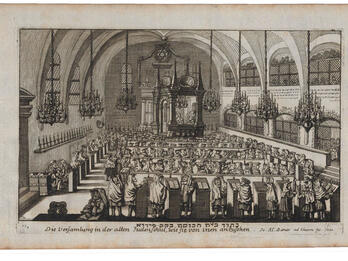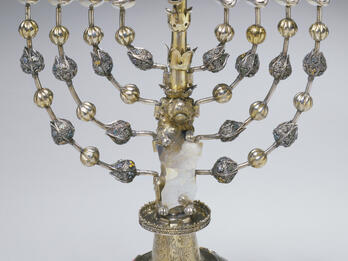Sifte kohen (Lips of the Priest)
That which God puts in my mouth I shall express (Numbers 22:38) in succinct and easy language, so that it will be simple for the discerning to grasp. And my purpose is to inform everyone to whom this work of mine reaches that I have not composed this work to issue halakhic rulings arrogantly [see m. Avot 6:6]—heaven forbid—and to say “Accept my view,” as they, not I, have the right [in this regard; see m. Avot 4:8]. As I am but young, and accordingly I held myself back and did not dare [see Job 32:6], for I am bereft of knowledge, despised of people, a worm and no man [see Psalms 22:7]. Albeit I have toiled hard, with earnestness and integrity, wearying myself to excess, not involving myself in any extraneous affairs, allowing my eyes no sleep and my eyelids no slumber [see Psalms 132:4] for many years, until I had brought my design into fruition. And I sifted and weighed everything in the balance, and reviewed all its major and minor aspects not just once or twice, but a hundred and one times, with esteemed, beloved, amiable, and pleasant colleagues who paid heed to my words. And anyone outside my immediate circle would not believe it if he were informed of the magnitude of the travails to which I was subjected in wading through the ocean of the Talmud and the halakhic decisors [poskim] until I had set forth everything in proper order.
Despite all this, I knew for sure that one cannot have grain without chaff [see Jeremiah 23:28], for who can discern his own errors [see Psalms 19:13]? Thus I have come to implore every reader of this work of mine and make him swear that he will not rely upon my decisions, rulings, and judgment, as no student of my ilk can decide as between the great and illustrious mountains, our teacher, R. Joseph Karo and our teacher, R. Moses Isserles, my venerable father-in-law, and the other authors from whose waters we drink. Their little finger is thicker than my loins [see 1 Kings 12:9], and, how much more so—a fortiori!—I am unfit to argue with and criticize them. I have, however, composed my statements in the style of analytical dialectics and two-way discussions, and he who perceives this will distinguish, and taste the words as one does a scrumptious dish, and after thorough investigation and inquiry, let him choose that which he wishes [see Numbers 16:5]! But my witness is in heaven that I have constantly aimed at writing in a succinct style; thus, should any litigant wish to dissent from me, permission is granted to all whom God has caused to delight in His Torah to search into and investigate my statements insofar as he is capable of so doing and his intellect permits. Only, they must cite clear proofs; let them bring their witnesses, that they may be justified (Isaiah 43:9). For it is not my intention—heaven forbid—to insist upon my opinion, for the truth will show its own path. I have not set out to create acrimony among the students, as I come from the seed of Aaron, who loved peace and pursued peace [see m. Avot 1:12].
And I have called this work of mine Sifte kohen [Lips of the Priest] in light of the biblical verse: the lips of the priest shall preserve knowledge, etc. (Malachi 2:7). May God, who has shepherded me throughout my life [see Genesis 48:15], help me and grant me the merit to publish the other works I have composed as well. And may He assist me in learning and teaching the true Torah—may it never depart from my mouth—and to compose endless works without impediment, and may He protect me from error. In You, O Lord, have I trusted, and I shall never be put to shame [see Psalms 25:2]!
Shabbetai, son of my master, my father, our illustrious teacher, R. Meir Katz.
Credits
Shabbetai ha-Kohen Katz Sifte kohen (Lips of the Priest) (Kraków: Segal, 1646/47). Republished in: Shulḥan ‛arukh: Yoreh de‛ah, vol. 1 (Jerusalem, n.d.), p. 1a.
Published in: The Posen Library of Jewish Culture and Civilization, vol. 5.




